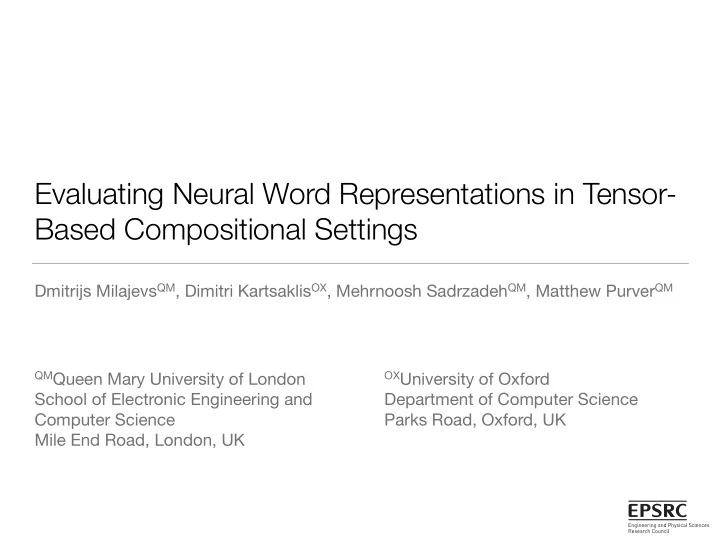

Evaluating Neural Word Representations in Tensor- Based Compositional Settings Dmitrijs Milajevs QM , Dimitri Kartsaklis OX , Mehrnoosh Sadrzadeh QM , Matthew Purver QM QM Queen Mary University of London OX University of Oxford School of Electronic Engineering and Department of Computer Science Computer Science Parks Road, Oxford, UK Mile End Road, London, UK
Modelling word and sentence meaning 2
Formal semantics John : j Mary : m saw : λ x. λ y.saw(y,x) John saw Mary : saw(j, m) 3
Distributional hypothesis • Word similarity • John is more similar to Mary that to idea . • Sentence similarity • Dogs chase cats vs. Hounds pursue kittens vs. Cats chase dogs vs. Students chase deadline 4
Distributional approach For each target word A lorry might carry sweet apples and a neighbouring context words A lorry might carry sweet apples update a co-occurrence matrix might sweet red … carry +1 +1 +0 … 5
Similarity of two words ~ distance between vectors 6
Neural word embeddings (language modelling) Corpus: The cat is walking in the bedroom Unseen A dog was running in a room should be almost as likely, because of similar semantic and grammatical roles. Bengio et al., 2006 Mikolov et al. scaled up the estimation procedure to a large corpus and provided a dataset to test extracted relations. 7
Tensor based models
Representing verb as a matrix General duality theorem: tensors are in one–one correspondence with multilinear maps. Bourbaki, ‘89 z 2 V ⌦ W ⌦ · · · ⌦ Z ⇠ = f z : V ! W ! · · · ! Z In a tensor based model, transitive verbs are matrices. Relational X Sbj i ⌦ � � � ! � ! X Verb = Obj i i Kronecker Verb = � Verb ⌦ � � ! � ! g Verb 9
Compositional models for (Obj, Verb, Sbj) g � g ⌦ Mitchell and Lapata ‘08 Kartsaklis et al. ‘12 Copy object: Sbj � ( Verb ⇥ � � ! ! Addition � Sbj � ( Verb ⇥ � ! ! Obj ) Obj ) � ! � ! � ! T ⇥ � ! Copy subject: Multiplication Obj � ( Verb Sbj ) � ! � ! � � · · · � Grefenstette and Sadrzadeh ‘11 Kartsaklis and Sadrzadeh ‘14 Verb � ( � Sbj ⌦ � ! ! Relational: Frobenius addition Verb � ( � Sbj ⌦ � ! ! Obj ) Obj ) � ! � ! Verb � ( � Sbj ⌦ � ! ! Kronecker: Frobenius multiplication g Obj ) Frobenius outer 10
Experiments 11
Vector spaces GS11 : BNC, lemmatised, 2000 dimensions, PPMI KS14 : ukWaC, lemmatised, 300 dimensions, LMI, SVD NWE : Google news, 300 dimensions, word2vec 12
Disambiguation Grefenstette and Sadrzadeh ’11 and ‘14 satisfies System meets specification visits 13
Similarity of sentences Grefenstette and Sadrzadeh ’11 and ‘14 System satisfies specification System meets specification System visits specification 14
Verb only baseline satisfy System meets specification visit 15
Disambiguation results Method GS11 KS14 NWE Verb only 0.212 0.325 0.107 Addition 0.103 0.275 0.149 Multiplication 0.348 0.041 0.095 Kronecker 0.304 0.176 0.117 Relational 0.285 0.341 0.362 Copy subject 0.089 0.317 0.131 0.456 Copy object 0.334 0.331 Frobenius add. 0.261 0.344 0.359 Frobenius mult. 0.233 0.341 0.239 Frobenius out. 0.284 0.350 0.375 Spearman rho 16
Sentence similarity Kartsaklis, Sadrzadeh, Pulman (CoNLL ’12) Kartsaklis, Sadrzadeh (EMNLP ‘13) panel discuss issue project present problem man shut door gentleman close eye paper address question study pose problem 17
Sentence similarity Method GS11 KS14 NWE Verb only 0.491 0.602 0.561 0.732 Addition 0.682 0.689 Multiplication 0.597 0.321 0.341 Kronecker 0.581 0.408 0.561 Relational 0.558 0.437 0.618 Copy subject 0.370 0.448 0.405 Copy object 0.571 0.306 0.655 Frobenius add. 0.566 0.460 0.585 Frobenius mult. 0.525 0.226 0.387 Frobenius out. 0.560 0.439 0.662 Spearman rho 18
Paraphrasing • MS Paraphrasing corpus • Compute similarity of a pair of sentences • Choose a threshold similarity value on training data • Evaluate on the test set 19
Paraphrase results Method GS11 KS14 NWE 0,73 (0,82) Addition 0,62 (0,79) 0,70 (0,80) Multiplication 0,52 (0,58) 0,66 (0,80) 0,42 (0,34) Accuracy (F-Score) 20
̃ Dialogue act tagging Milajevs and Purver ’14, Serafin et al. ’03 Switchboard: telephone conversation corpus. 1. Utterance-feature matrix I ⊕ wonder ⊕ if ⊕ that ⊕ worked ⊕ . 2. Utterance vectors are M ≈ U ∑̃ V T = M reduced using SVD to 50 dimensions 3. k-nearest neighbours classification 21
Dialogue act tagging results NWE Method GS11 KS14 NWE lemmatised 0,63 (0,60) Addition 0,35 (0,35) 0,40 (0,35) 0,44 (0,40) Multiplication 0,32 (0,16) 0,39 (0,33) 0,43 (0,38) 0,58 (0,53) Accuracy (F-Score) 22
Discussion “ context-predicting models obtain a thorough and resounding victory against their count-based counterparts ” Baroni et al. (2014) “ analogy recovery is not restricted to neural word embeddings [...] a similar amount of relational similarities can be recovered from traditional distributional word representations ” Levy et al. (2014) “ shallow approaches are as good as more computationally intensive alternatives on phrase similarity and paraphrase detection tasks” Blacoe and Lapata (2012) 23
Improvement over baselines Task GS11 KS14 NWE + Disambiguation + + Sentence - + + similarity + Paraphrase - + Dialog act + - - tagging 24
Conclusion The choice of compositional operator seems to be more • important than the word vector nature and more task specific. Tensor-based composition does not yet always outperform • simple compositional operators. Neural word embeddings are more successful than the co- • occurrence based alternatives. Corpus size might contribute a lot. • 25
Recommend
More recommend